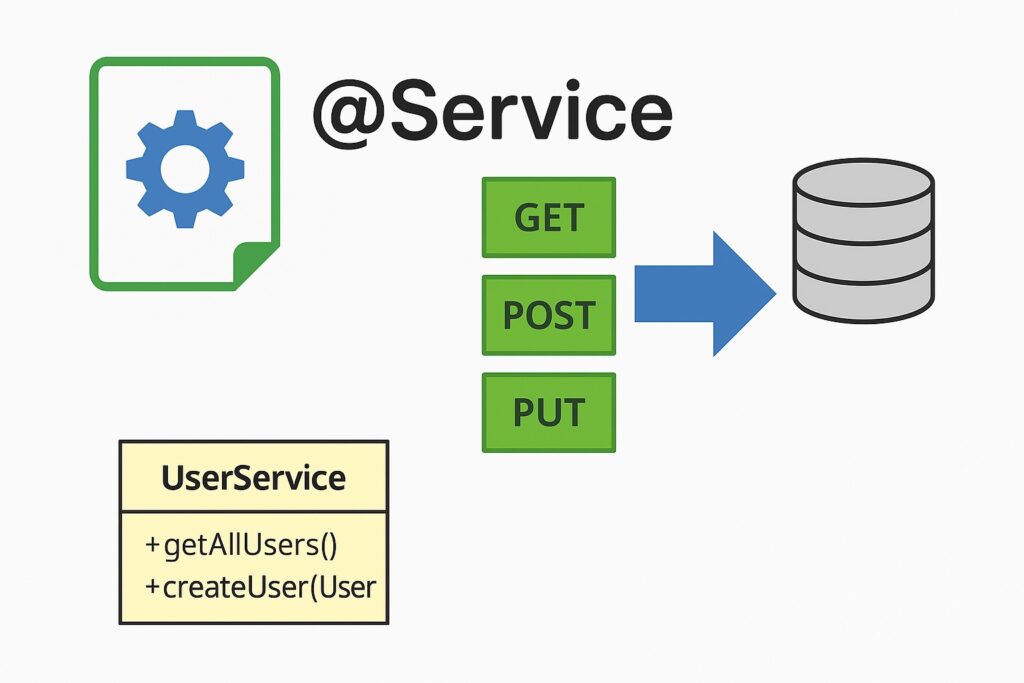The @Service annotation in Spring Boot is one of the core stereotype annotations used to define business logic in a Spring application. It is a specialized form of the @Component annotation and is used to mark a class as a service provider.
In this article, we will dive deep into what @Service is, how it works, and how you can use it effectively in your Spring Boot applications.
What Is @Service?
The @Service annotation is used to indicate that a class is holding the business logic. Spring will autodetect these classes through classpath scanning and register them as Spring Beans in the application context.
@Target({ElementType.TYPE})
@Retention(RetentionPolicy.RUNTIME)
@Documented
@Component
public @interface Service {
String value() default "";
}As you can see above, @Service is a meta-annotation built on top of @Component, which means it has the same behavior but is semantically clearer for service-layer logic.
Why Use @Service?
Using @Service has several benefits:
- Makes your code more readable and well-structured.
- Helps Spring manage business logic as beans.
- Supports AOP (Aspect-Oriented Programming) features like transaction management and logging.
When to Use It?
Use @Service when your class contains business logic — for example, calculations, decision-making, data processing, or coordination between repositories and other services.
A Full Example: Spring Boot Service Layer
Let’s walk through an example application that manages a list of users.
1. Project Structure
com.example.userservice
├── controller
│ └── UserController.java
├── model
│ └── User.java
├── repository
│ └── UserRepository.java
├── service
│ └── UserService.java
└── Application.java2. User Model
package com.example.userservice.model;
public class User {
private Long id;
private String name;
// Constructors
public User() {}
public User(Long id, String name) {
this.id = id;
this.name = name;
}
// Getters and Setters
public Long getId() { return id; }
public void setId(Long id) { this.id = id; }
public String getName() { return name; }
public void setName(String name) { this.name = name; }
}3. User Repository (Mock)
package com.example.userservice.repository;
import com.example.userservice.model.User;
import org.springframework.stereotype.Repository;
import java.util.*;
@Repository
public class UserRepository {
private final Map<Long, User> database = new HashMap<>();
public List<User> findAll() {
return new ArrayList<>(database.values());
}
public void save(User user) {
database.put(user.getId(), user);
}
}4. User Service with @Service
package com.example.userservice.service;
import com.example.userservice.model.User;
import com.example.userservice.repository.UserRepository;
import org.springframework.beans.factory.annotation.Autowired;
import org.springframework.stereotype.Service;
import java.util.List;
@Service
public class UserService {
private final UserRepository userRepository;
@Autowired // Constructor Injection
public UserService(UserRepository userRepository) {
this.userRepository = userRepository;
}
public List<User> getAllUsers() {
return userRepository.findAll();
}
public void createUser(User user) {
userRepository.save(user);
}
}5. User Controller
package com.example.userservice.controller;
import com.example.userservice.model.User;
import com.example.userservice.service.UserService;
import org.springframework.beans.factory.annotation.Autowired;
import org.springframework.web.bind.annotation.*;
import java.util.List;
@RestController
@RequestMapping("/users")
public class UserController {
@Autowired
private UserService userService;
@GetMapping
public List<User> getUsers() {
return userService.getAllUsers();
}
@PostMapping
public String addUser(@RequestBody User user) {
userService.createUser(user);
return "User added successfully";
}
}Summary
@Serviceis used to annotate service classes that contain business logic.- It makes the application easier to manage and test.
- Together with
@Repositoryand@Controller, it forms the foundation of a clean, layered architecture in Spring Boot.



